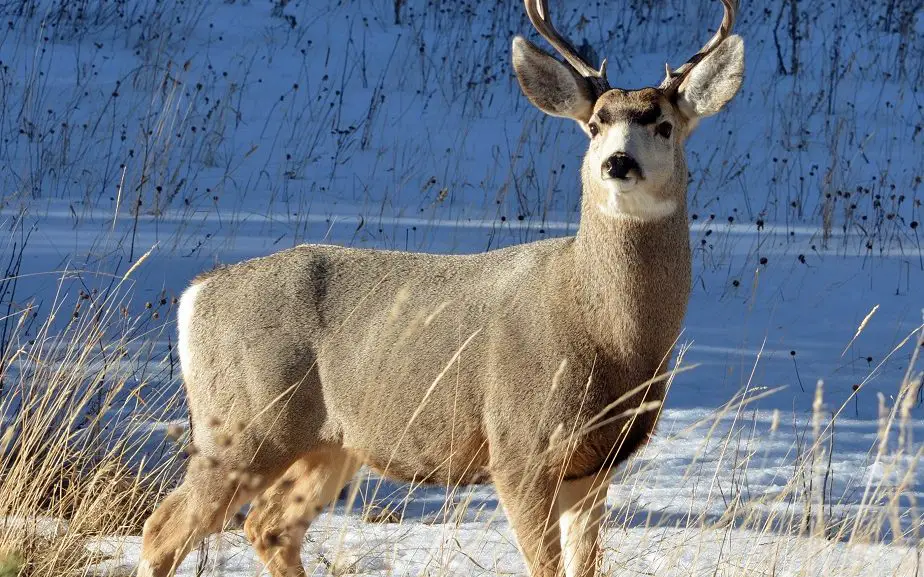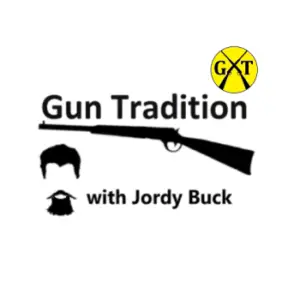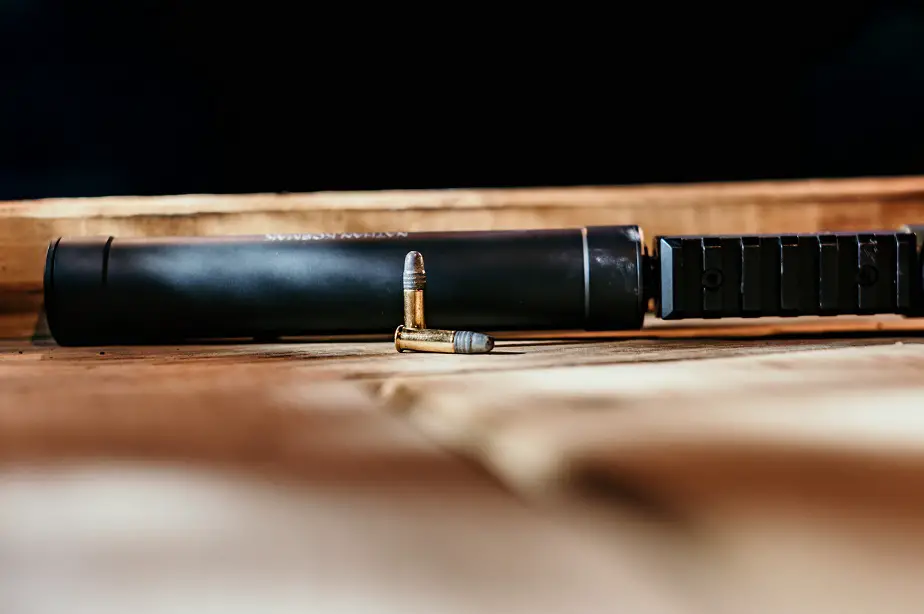Many survival guns are small 22lr rifles or pistols. This article addresses the use of such guns to take deer. This article is purely a theoretical survival scenario. Hunting deer with a 22 rimfire is poaching in all 50 states.
To Kill a deer with a 22, you have to hit the central nervous system. The brain, brain stem, and first 4 inches of the spinal column are the only dependable targets, and will also result in an instant, clean kill. Body shots or shots to the lower neck stand a high chance of not recovering the animal.
I’ve gathered a lot of ballistic data and first-hand experience. If you really want to know how to kill deer with a 22 in a survival situation, well here we go.

How to Drop a Deer With a 22
If you needed to drop a deer with a 22, the bullet needs to enter the brain or upper spine. The slow velocity of 22lr means that the bullet will only destroy tissue that it directly touches. Since it is a low power round, you have to shoot a spot that will kill with very little penetration.
Body shots are out of the question. There just is not enough wounding potential. Here’s why. The 22lr does not create any feasible amount of hydrostatic shockwave in muscle tissue. According to a surgeon who specializes in gunshot wounds, “it will only destroy tissue that it actually touches. No wider wound may be made at these velocities”
With larger rifle rounds, the wound is generally much larger than the diameter of the bullet. Not so with the 22lr. With a hunting rifle, we prefer long shots. Puncture the lungs so the animal can’t replenish oxygen in the blood, and the extra shock will pulverize the lungs, destroying major arteries and veins in the lungs.
A 22 will poke a hole in the lungs, and it may eventually cause a deer to suffocate if the wound doesn’t clot over. But the deer will run all day long as you track it, eventually outrunning your skill or dedication to track it. The 22 has a very low chance of severing an artery with a lung shot.
If you want to try a heart shot, don’t do that either. The heart is half covered by the deer’s shoulder. The shoulder is a heavy bone with some pretty stout muscle on it. now, if you shot a deer in the heart with a 22, it will die, and it may not take too long, but there will be no blood trail.
As a serious question, how good are you at tracking? Can you track a deer without a blood trail? To date, I’ve not met a hunter that could. If a deer heart shot with a 30-06 can go a hundred yards through a swamp before expiring, a 22 will let it go a lot further.
The only way to instantly kill a deer with anything, including a 22, is to destroy the first leg of the central nervous system. That is the brain, brainstem, and first 4 inches of the spinal column.
On an adult deer, the brain is 3 to 4 inches wide, and about 3 inches tall. The brainstem and spinal column are only about half an inch wide. But, as long as you hit the spine itself, anywhere inside of 100 yards it has enough energy to damage or sever the spinal column. The vertebrae are about 2 inches wide.
The issue with a front-on shot is that due to the layout of the skull, it’s hard to hit the brain and that the first few inches of a deer’s neck are usually obstructed by its chin. That’s why I’d recommend a side shot if you had to shoot a deer with a 22 in a survival situation.

What Part of the Head is a Deer’s Brain in Exactly?
Looking at a deer’s skull, the brain is in the rearmost 3 to 4 inches. Because of this, the only real shot to reach the brain with a 22lr is from the side. You’ve probably heard something like “I could kill a deer with a 22, just shoot em’ between the eyes”. That’s not entirely realistic.
You could make it happen, but you’d have to shoot slightly above the eyes and you only have a target of about an inch. The issue here is the shape and design of a deer’s skull. In the front of the skull, you have a nose and a huge muzzle. Then there’s the sinus cavity that goes right between the eyes.
The sinus cavity is about 2-3 inches thick between the eyes, and there’s a heavy bone layer on both sides of it. The forehead of a deer (right between the eyes) I the thickest part of a deer’s skull. And it gets significantly thicker and denser on older deer.
It takes a lucky shot to drop a deer with a 22 right between the eyes, and especially so with the larger-bodied northern Whitetail. The best easiest spot to reach the brain is from the side. That’s where the bone is the thinnest, and there’s no other skull structure to get in the way.
The most vulnerable spot for a deer’s brain is from the side, the back three inches of the skull. That’s a small target, but hey, you wanted to know how to do it with a 22.
Will a Deer Skull Deflect a Bullet?
A deer skull can deflect a 22lr bullet. The long sloping front of a deer’s skull has a high tendency to completely ricochet a 22lr bullet unless the deer’s head was down at the time. If a deer has its head up and you shoot it straight on, there’s a likelihood of some deflection.
It’s really about angles. Look at a deer’s skull sometimes. The slope at the front, where the muzzle and the forehead begin is an easy slope. If the skull is down, in a feeding position, and you hit it straight on, there’s very little chance of deflection. But if it’s up, in an alert position, you have bone structure against you.
Even from the side, you can ricochet the bullet of the skull if you shoot at too much angle. As the bullet impacts, the closer to a right angle it is, the less likely it is to ricochet and the better it will penetrate and destroy brain tissue.

How Far Would a 22 Kill a Deer
With proper ammo and perfect shot placement, you should be able to fully penetrate the side of a deer’s brain cavity at 200 yards with a 22lr rifle. It would require expert knowledge of a deer’s anatomy, a good marksman, and a still deer to best increase your chances.
Realistically, a 22 is potentially lethal to around 400 yards and can wound a bit further. The big limiter is your personal accuracy and marksmanship skill. Well, that and being able to identify where the brain is located n the skull.
Also consider the low velocity of a 22, or more specifically, the time in flight. An average 22lr takes a bit over half a second to go 200 yards. That sort of shot could only be done if a deer was perfectly still, and who’s to say it won’t move after you squeeze the trigger?
Realistically, given the mall size of the target and the frequency of movement with a deer, the practical distance of such a shot is limited to around 25 yards with iron sight, and 75 yards with a scope.
Would Solids or Hollow Points be Better?
Solid lead bullets are best for making headshots on a deer with a 22lr. Solid bullets tend to be heavier and will perform better for bone penetration ad buck the wind better than hollow points, which will not penetrate the skull as well. Under 50 yards, both should perform about the same.

What 22 Ammo Could Kill a Deer
Any 22lr ammo could work, but the best option is undeniably the most powerful option. The heavier, hyper-speed ammo like Aguila Interceptors. Most survivalist experts prefer the solid lead CCI minimag. It’s a very accurate, affordable round that is also faster than average.
Can I Spine Shoot a Deer?
A spine shot on a deer will cause a deer to drop instantly. Hitting the vertebrae, even if your bullet doesn’t directly impact the spinal column, will destroy its function below that point. If shot in the first 4 vertebrae, it will be a kill shot.
22LR vs 22Mag for Survival Deer Hunting?
Neither the 22lr nor 22mag are suitable for practical deer hunting and are illegal in most states (I think North Carolina doesn’t have caliber restrictions for deer hunting). It’s been used in survival situations and by poachers. The 22 mag is better than 22lr because it’s more powerful, faster, and has FMJ ammo available.
Could a 22 be a Good Survival Hunting Rifle?
A 22 is a poor choice for a survival gun. It’s adequate for hunting small game but is vastly underpowered for large game, which is a valuable food source in a survival situation. A more powerful gun is a much better option.

